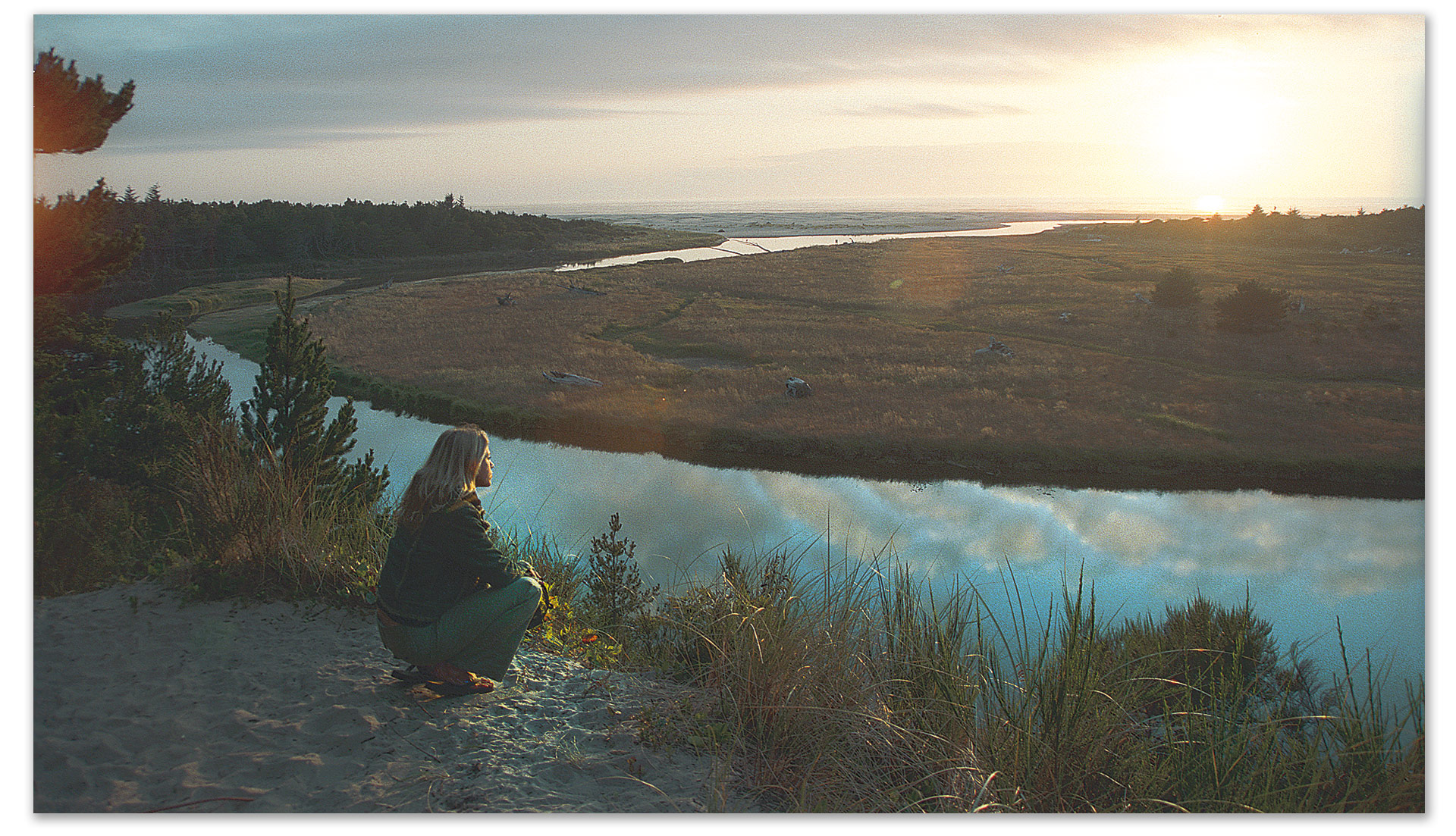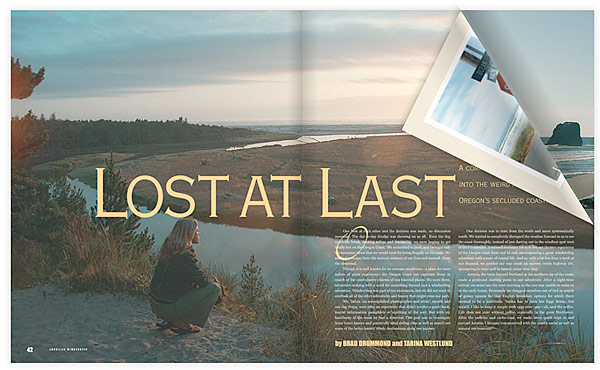
ONE LOOK AT each other and the decision was made, no discussion necessary. The day-to-day drudge was showing on us all. Even the dog needed a break. Seeking refuge and tranquility, we were hoping to get totally lost on the Oregon Coast. We scrambled to pack and brought only the necessary items that we would need for living frugally on the coast. We needed to escape from the normal routines of our lives and instead, chase the abnormal.
Though it is well known for its extreme conditions—a place for wave sailors of great experience—the Oregon Coast can captivate those in search of the most elusive charms of less traveled places. We were three, adventure-seeking with a need for something beyond just a windsurfing adventure. Windsurfing was part of our motivation, but we did not want to overlook all of the other adventures and beauty that might cross our path.
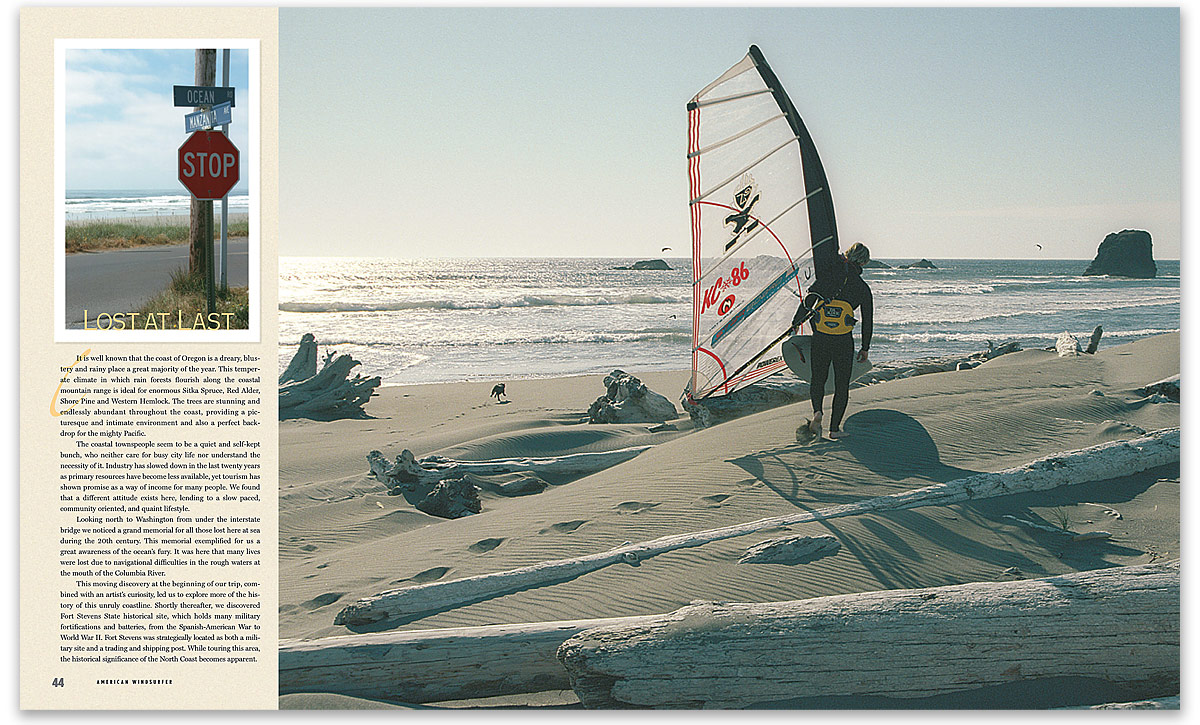
Though it is well known for its extreme conditions—a place for wave sailors of great experience—the Oregon Coast can captivate those in search of the more elusive charms of less traveled places. We were three, adventure-seeking with a need for something beyond just a windsurfing adventure. Windsurfing was part of our motivation, but we did not want to overlook all of the other adventures and beauty that might cross our path.
We, Tarina (an accomplished photographer and artist), myself, and our dog Freya, were after an experience that didn’t involve a guide book, tourist information pamphlets or anything of the sort. But with my familiarity of the coast we had a direction. Our goal was to investigate some lesser known and potentially ideal sailing sites as well as search out some of the better known windy destinations along our journey.
Our decision was to start from the north and move systematically south. We wanted to completely disregard the weather forecast so as to see the coast thoroughly, instead of just darting out to the windiest spot west of the I-5 corridor. It seemed necessary for us to live out the true experience of the Oregon coast from end to end, encompassing a great windsurfing adventure with a taste of coastal life. And so, with a bit less than a week at our disposal, we ambled our way south on narrow, twisty highway 101, attempting to tame and be tamed, come what may.
Astoria, the town beyond Portland at the northern tip of the coast, made a profound starting point for our adventure. After a night-time arrival, we arose late the next morning as the sun was unable to wake us in the early hours. Eventually, we dragged ourselves out of bed in search of greasy spoons for that English breakfast, options for which there seemed to be a multitude. Tarina has to have her Eggs Benny, but myself, I like to keep it simple with eggs over easy—oh, and the coffee. Life does not exist without coffee, especially in the great Northwest. After the caffeine and carbo-load, we made some quick trips in and around Astoria. I became reacquainted with the coast’s social as well as natural environment.
It is well known that the coast of Oregon is a dreary, blustery and rainy place a great majority of the year. This temperate climate in which rain forests flourish along the coastal mountain range is ideal for enormous Sitka Spruce, Red Alder, Shore Pine and Western Hemlock. The trees are stunning and endlessly abundant throughout the coast, providing a picturesque and intimate environment and also a perfect backdrop for the mighty Pacific.
The coastal townspeople seem to be a quiet and self-kept bunch, who neither care for busy city life nor understand the necessity of it. Industry has slowed down in the last twenty years as primary resources have become less available, yet tourism has shown promise as a way of income for many people. We found that a different attitude exists here, lending to a slow paced, community oriented, and quaint lifestyle.
Looking north to Washington from under the interstate bridge we noticed a grand memorial for all those lost here at sea during the 20th century. This memorial exemplified for us a great awareness of the ocean’s fury. It was here that many lives were lost due to navigational difficulties in the rough waters at the mouth of the Columbia River.
This moving discovery at the beginning of our trip, combined with an artist’s curiosity, led us to explore more of the history of this unruly coastline. Shortly thereafter, we discovered Fort Stevens State historical site, which holds many military fortifications and batteries, from the Spanish-American War to World War II. Fort Stevens was strategically located as both a military site and a trading and shipping post. While touring this area, the historical significance of the North Coast becomes apparent.
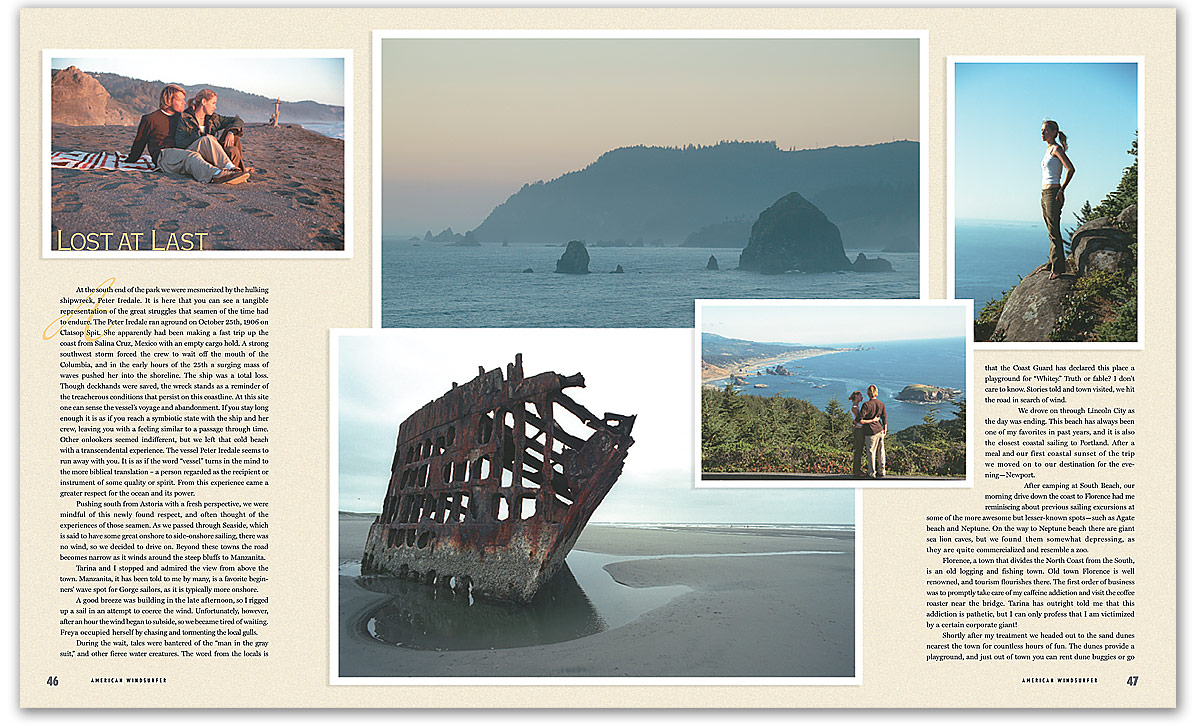
At the south end of the park we were mesmerized by the hulking shipwreck, Peter Iredale. It is here that you can see a tangible representation of the great struggles that seamen of the time had to endure. The Peter Iredale ran aground on October 25th, 1906 on Clatsop Spit. She apparently had been making a fast trip up the coast from Salina Cruz, Mexico with an empty cargo hold. A strong southwest storm forced the crew to wait off the mouth of the Columbia, and in the early hours of the 25th a surging mass of waves pushed her into the shoreline. The ship was a total loss. Though deckhands were saved, the wreck stands as a reminder of the treacherous conditions that persist on this coastline. At this site one can sense the vessel’s voyage and abandonment. If you stay long enough it is as if you reach a symbiotic state with the ship and her crew, leaving you with a feeling similar to a passage through time. Other onlookers seemed indifferent, but we left that cold beach with a transcendental experience. The vessel Peter Iredale seems to run away with you. It is as if the word “vessel” turns in the mind to the more biblical translation – a person regarded as the recipient or instrument of some quality or spirit. From this experience came a greater respect for the ocean and its power.
Pushing south from Astoria with a fresh perspective, we were mindful of this newly found respect, and often thought of the experiences of those seamen. As we passed through Seaside, which is said to have some great onshore to side-onshore sailing, there was no wind, so we decided to drive on. Beyond these towns the road becomes narrow as it winds around the steep bluffs to Manzanita.
Tarina and I stopped and admired the view from above the town. Manzanita, it has been told to me by many, is a favorite beginners’ wave spot for Gorge sailors, as it is typically more onshore.
A good breeze was building in the late afternoon, so I rigged up a sail in an attempt to coerce the wind. Unfortunately, however, after an hour the wind began to subside, so we became tired of waiting. Freya occupied herself by chasing and tormenting the local gulls.
During the wait, tales were bantered of the “man in the gray suit,” and other fierce water creatures. The word from the locals is that the Coast Guard has declared this place a playground for “Whitey.” Truth or fable? I don’t care to know. Stories told and town visited, we hit the road in search of wind.
We drove on through Lincoln City as the day was ending. This beach has always been one of my favorites in past years, and it is also the closest coastal sailing to Portland. After a meal and our first coastal sunset of the trip we moved on to our destination for the evening—Newport.
After camping at South Beach, our morning drive down the coast to Florence had me reminiscing about previous sailing excursions at some of the more awesome but lesser-known spots—such as Agate beach and Neptune. On the way to Neptune beach there are giant sea lion caves, but we found them somewhat depressing, as they are quite commercialized and resemble a zoo.
Florence, a town that divides the North Coast from the South, is an old logging and fishing town. Old town Florence is well renowned, and tourism flourishes there. The first order of business was to promptly take care of my caffeine addiction and visit the coffee roaster near the bridge. Tarina has outright told me that this addiction is pathetic, but I can only profess that I am victimized by a certain corporate giant!
Shortly after my treatment we headed out to the sand dunes nearest the town for countless hours of fun. The dunes provide a playground, and just out of town you can rent dune buggies or go on a group tour of the dunes in an oversize buggy. Traveling out through the Suislaw State Park in the afternoon we found wind and wave conditions at the South Jetty. Conditions were marginal, but great for having traveled to the coast on a whim. The jetty sees plenty of extreme wave sailing in the summer months with some mast-high and windy days. I’ve rarely been disappointed here.
Conditions were marginal but great for having traveled to the coast on a whim. The jetty sees plenty of extreme wave sailing in the summer months with some mast-high and windy days. I’ve rarely been disappointed here.
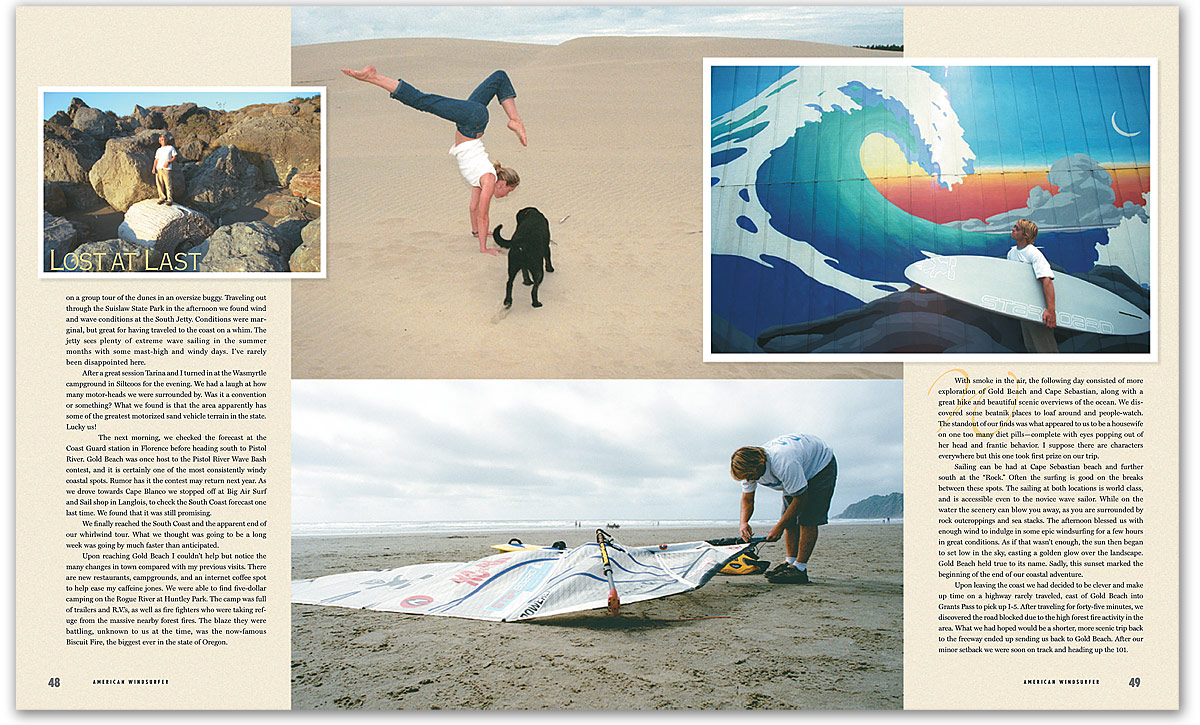
After a great session Tarina and I turned in at the Wasmyrtle campground in Siltcoos for the evening. We had a laugh at how many motor-heads we were surrounded by. Was it a convention or something? What we found is that the area apparently has some of the greatest motorized sand vehicle terrain in the state. Lucky us!
The next morning, we checked the forecast at the Coast Guard station in Florence before heading south to Pistol River. Gold Beach was once host to the Pistol River Wave Bash contest, and it is certainly one of the most consistently windy coastal spots. Rumor has it the contest may return next year. As we drove towards Cape Blanco we stopped off at Big Air Surf and Sail shop in Langlois, to check the South Coast forecast one last time. We found that it was still promising.
We finally reached the South Coast and the apparent end of our whirlwind tour. What we thought was going to be a long week was going by much faster than anticipated.
Upon reaching Gold Beach I couldn’t help but notice the many changes in town compared with my previous visits. There are new restaurants, campgrounds, and an internet coffee spot to help ease my caffeine jones. We were able to find five-dollar camping on the Rogue River at Huntley Park. The camp was full of trailers and R.V.’s, as well as fire fighters who were taking refuge from the massive nearby forest fires. The blaze they were battling, unknown to us at the time, was the now-famous Biscuit Fire, the biggest ever in the state of Oregon.
With smoke in the air, the following day consisted of more exploration of Gold Beach and Cape Sebastian, along with a great hike and beautiful scenic overviews of the ocean. We discovered some beatnik places to loaf around and people-watch. The standout of our finds was what appeared to us to be a housewife on one too many diet pills—complete with eyes popping out of her head and frantic behavior. I suppose there are characters everywhere but this one took first prize on our trip.
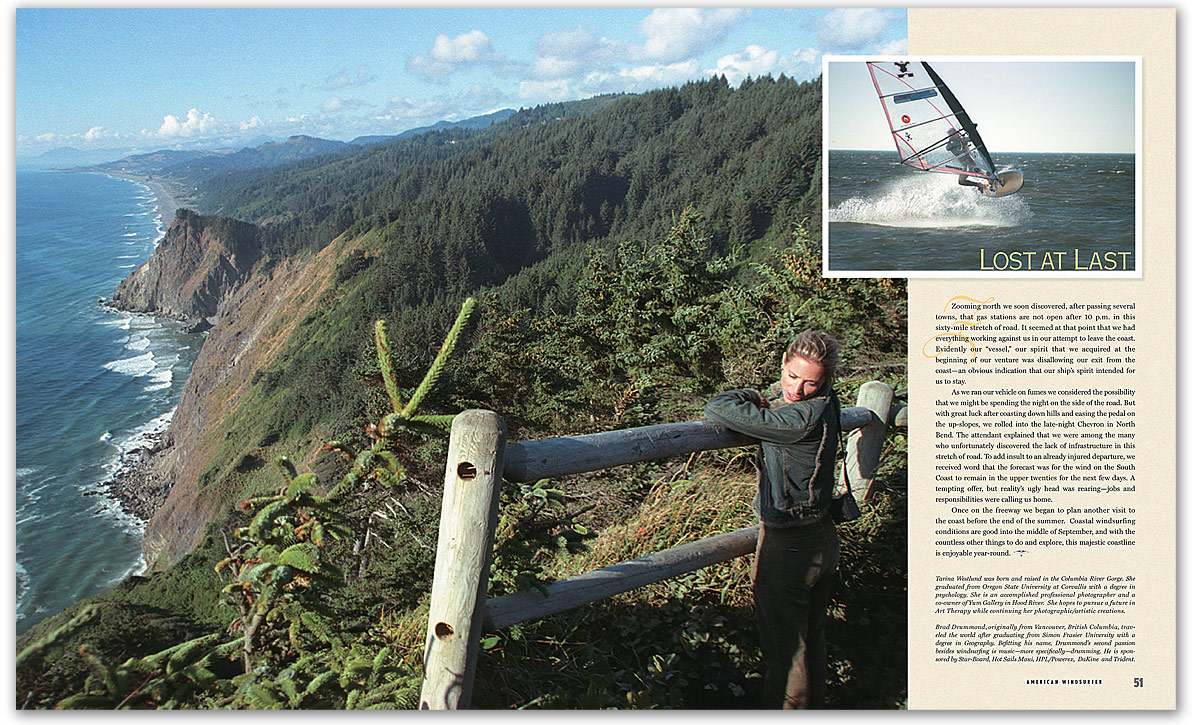
Sailing can be had at Cape Sebastian beach and further south at the “Rock.” Often the surfing is good on the breaks between these spots. The sailing at both locations is world class and is accessible even to the novice wave sailor. While on the water the scenery can blow you away, as you are surrounded by rock outcroppings and sea stacks. The afternoon blessed us with enough wind to indulge in some epic windsurfing for a few hours in great conditions. As if that wasn’t enough, the sun then began to set low in the sky, casting a golden glow over the landscape. Gold Beach held true to its name. Sadly, this sunset marked the beginning of the end of our coastal adventure.
Upon leaving the coast we had decided to be clever and make up time on a highway rarely traveled, east of Gold Beach into Grants Pass to pick up I-5. After traveling for forty-five minutes, we discovered the road blocked due to the high forest fire activity in the area. What we had hoped would be a shorter, more scenic trip back to the freeway ended up sending us back to Gold Beach. After our minor setback we were soon on track and heading up the 101.
Zooming north we soon discovered, after passing several towns, that gas stations are not open after 10 p.m. in this sixty-mile stretch of road. It seemed at that point that we had everything working against us in our attempt to leave the coast. Evidently our “vessel,” our spirit that we acquired at the beginning of our venture was disallowing our exit from the coast—an obvious indication that our ship’s spirit intended for us to stay.
As we ran our vehicle on fumes we considered the possibility that we might be spending the night on the side of the road. But with great luck after coasting down hills and easing the pedal on the up-slopes, we rolled into the late-night Chevron in North Bend. The attendant explained that we were among the many who unfortunately discovered the lack of infrastructure in this stretch of road. To add insult to an already injured departure, we received word that the forecast was for the wind on the South Coast to remain in the upper twenties for the next few days. A tempting offer but reality’s ugly head was rearing—jobs and responsibilities were calling us home.
Once on the freeway, we began to plan another visit to the coast before the end of the summer. Coastal windsurfing conditions are good into the middle of September, and with the countless other things to do and explore, this majestic coastline is enjoyable year-round.
Tarina Westlund was born and raised in the Columbia River Gorge. She graduated from Oregon State University at Corvallis with a degree in psychology. She is an accomplished professional photographer and a co-owner of Yum Gallery in Hood River. She hopes to pursue a future in Art Therapy while continuing her photographic/artistic creations.
Brad Drummond, originally from Vancouver, British Columbia, traveled the world after graduating from Simon Frasier University with a degree in Geography. Befitting his name, Drummond’s second passion besides windsurfing is music—more specifically—drumming. He is sponsored by Star-Board, Hot Sails Maui, HPL/Powerex, DaKine and Trident.


